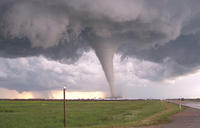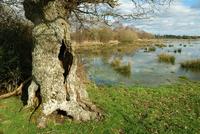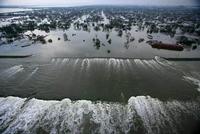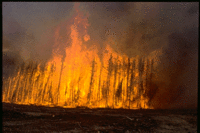-
Climate change may fuel extreme wildfires
Climate change may be fueling the larger and more destructive wildfires which are scorching vast areas of the American West, according to new research. August 2012 saw 3.6 million acres burn in the region, the most of any August since 2000. There were, however, only 6,948 fires in August 2012 — the second fewest in that 12-year timeframe — meaning the fires were much larger.
-
-
Quake Summit 2013: showcasing research on earthquakes, tsunamis
Members of a national earthquake simulation research network next week will gather at the University of Nevada, Reno (UNR), for Quake Summit 2013, a scientific meeting highlighting research on mitigating the impact of devastating earthquakes and tsunamis. Titled “Earthquake & Multi-Hazards Resilience: Progress and Challenges,” the annual summit of the 14-site George E. Brown Network for Earthquake Engineering Simulation (NEES), will run from 6 August through 8 August at UNR’s Joseph Crowley Student Center.
-
-
Online tools accelerate progress in earthquake engineering, science
A new study has found that on-line tools, access to experimental data, and other services provided through “cyberinfrastructure” are helping to accelerate progress in earthquake engineering and science. The cyberinfrastructure includes a centrally maintained, Web-based science gateway called NEEShub, which houses experimental results and makes them available for reuse by researchers, practitioners, and educational communities. NEEShub contains more than 1.6 million project files stored in more than 398,000 project directories and has been shown to have at least 65,000 users over the past year.
-
-
Simulations help in studying earthquake dampers for structures
Researchers have demonstrated the reliability and efficiency of “real-time hybrid simulation” for testing a type of powerful damping system that might be installed in buildings and bridges to reduce structural damage and injuries during earthquakes. The magnetorheological-fluid dampers are shock-absorbing devices containing a liquid that becomes far more viscous when a magnetic field is applied.
-
-
Raw cotton offers new, ecologically friendly way to clean up oil spills

The Deepwater Horizon disaster highlighted the need for better ways of cleaning up oil spills. A new solution addresses this need. It is based on the finding that unprocessed, raw cotton may be an ideal, ecologically friendly answer, with an amazing ability to sop up oil.
-
-
Tornadoes do not take weekends off

Do tornadoes take the weekends off? Some scientists had hypothesized that aerosols, which are more common in the atmosphere during the work week due to increased vehicle and manufacturing pollution levels, were also responsible for increased tornadic activity during Monday-Friday period. New research finds that the numbers of tornadoes that occurred on any given day of the week varied, with no clear pattern showing that weekends had significantly less activity.
-
-
U.K. winter flooding to get more severe, frequent

Winter flooding in the United Kingdom is set to get more severe and more frequent under the influence of climate change as a result of a change in the characteristics of atmospheric rivers (ARs). ARs are narrow regions of intense moisture flows in the lower troposphere of the atmosphere that deliver sustained and heavy rainfall to mid-latitude regions such as the United Kingdom.
-
-
Feds give upstate New York counties $5 million money to repair roads, bridges
The Federal Highway Administration (FHA) has approved $5 million in emergency funding to help fifteen upstate New York counties make repairs to their roads and bridges damaged in a flood late last month.
-
-
La. flood protection agency sues 97 energy companies for wetland destruction
A Louisiana state agency on Wednesday filed a lawsuit against ninety-seven energy companies, charging that the companies have inflicted severe damage on fragile coastal wetlands, damage which left New Orleans and other Louisiana cities more vulnerable to hurricanes and storm surges. The agency wants the court to order these companies to pay steep penalties which would help the state restore the wetlands and thus recreate the natural buffer which had protected New Orleans.
-
-
Changes to levee system would reduce storm surge risks to New Orleans: study

Historically, the design of Southeast Louisiana’s hurricane flood risk reduction system has hinged on raising and adding levees in response to river or hurricane events that impact the region. A new study shows that the lowering of man-made levees along 55-kilometer section of the west bank of the Lower Plaquemines river to their natural state, to allow storm surge to partially pass across the Mississippi River, will decrease storm surge upriver toward New Orleans.
-
-
Natural disasters caused $85 billion global economic loss during first half of 2013
Data show that economic losses from global natural disasters during the six month period ending 30 June totaled $85 billion (2012: 75 billion) — around 15 percent lower than the 10-year (2003-2012) average of $100 billion. Insured losses for the period reached $20 billion (2012: $25 billion) — approximately 20 percent below the 10-year average of $25 billion. Roughly 50 percent of the insured losses resulting from natural disaster events were recorded in the United States.
-
-
Motivating businesses to adopt building resiliency standards
Increased resilience for buildings in the face of hurricanes, earthquakes, terrorism, or cyberattacks has been a major national security focus over the past decade. Such resilient buildings not only would be less susceptible to damage and work interruption but could become community gathering places in a general crisis. It will not be easy, however, to secure voluntary adoption of resiliency standards by industry and builders without adequate justification.
-
-
Earthquake can have devastating long-distance impact
In 2006 the island of Java, Indonesia was struck by a devastating earthquake followed by the onset of a mud eruption to the east, flooding villages over several square kilometers, and which continues to erupt today. Until now, researchers believed the earthquake was too far from the mud volcano to trigger the eruption. Researchers used computer-based simulations to show that such triggering is possible over long distances because the seismic waves can be focused like in a parabolic reflector.
-
-
Wildfires to get more common, harder to control

Wildfires are getting worse, as evidenced by the devastation caused in Australia in 2009 and again last year, in Russia in 2010, in Canada’s Slave Lake and Colorado Springs in 2011, and in Arizona earlier this year. The world’s wildfires annually burn between 350 million and 600 million hectares of forest, an area equivalent to the size of India. Researchers predict that global warming will increase severity of wildfires threefold by end of century.
-
-
Predicting what could happen if Hurricane hits

A Sandia National Laboratories team is gearing up for hurricane season, readying analyses to help people in the eye of a storm. The team has two jobs: conducting annual “hurricane swath” analyses of probable impacts on the Gulf Coast and East Coast, and providing quick analyses of crisis response in the face of an imminent hurricane threat to the United States. A swath analysis looks at how a hurricane might interrupt critical services and at impacts to infrastructure specific to an area, such as petroleum and petrochemical industries in Houston or financial services in New York City. It also looks at such things as the economic impact of the storm or how it could upset food deliveries.
-
More headlines
The long view
Using Drone Swarms to Fight Forest Fires
Forest fires are becoming increasingly catastrophic across the world, accelerated by climate change. Researchers are using multiple swarms of drones to tackle natural disasters like forest fires.
How Climate Change Will Affect Conflict and U.S. Military Operations
By Doug Irving
“People talk about climate change as a threat multiplier,” said Karen Sudkamp, an associate director of the Infrastructure, Immigration, and Security Operations Program within the RAND Homeland Security Research Division. “But at what point do we need to start talking about the threat multiplier actually becoming a significant threat all its own?”
